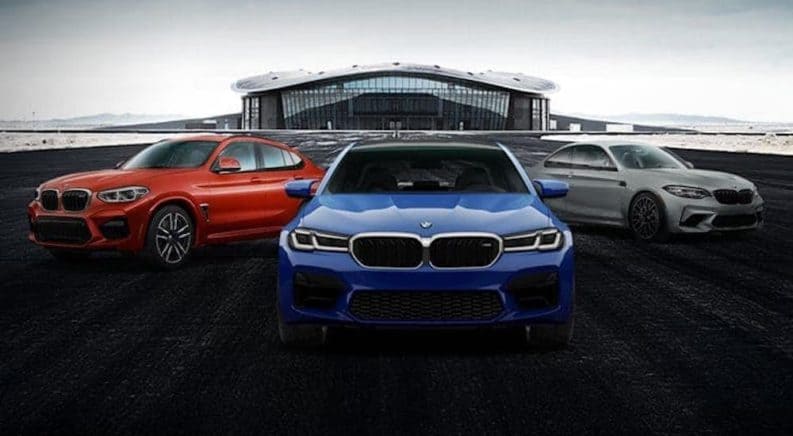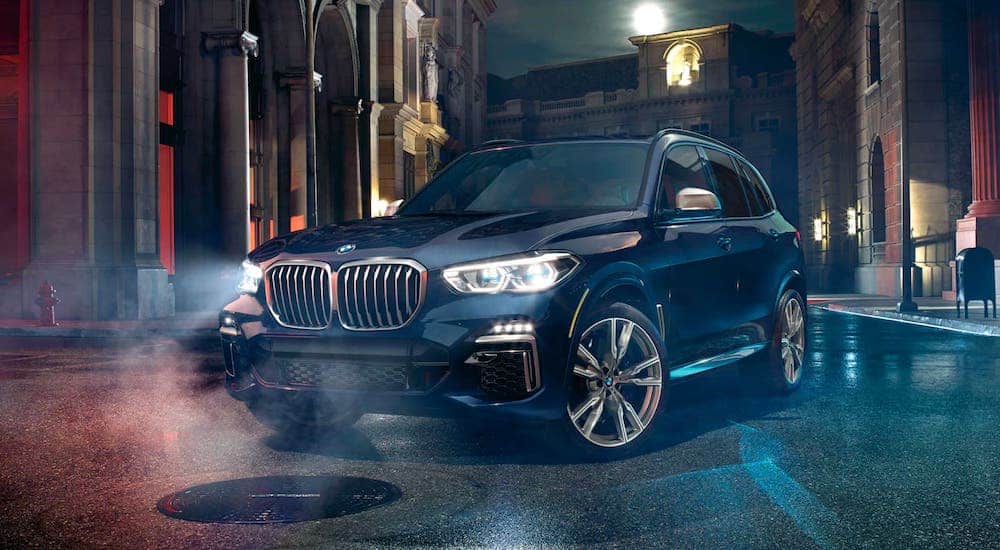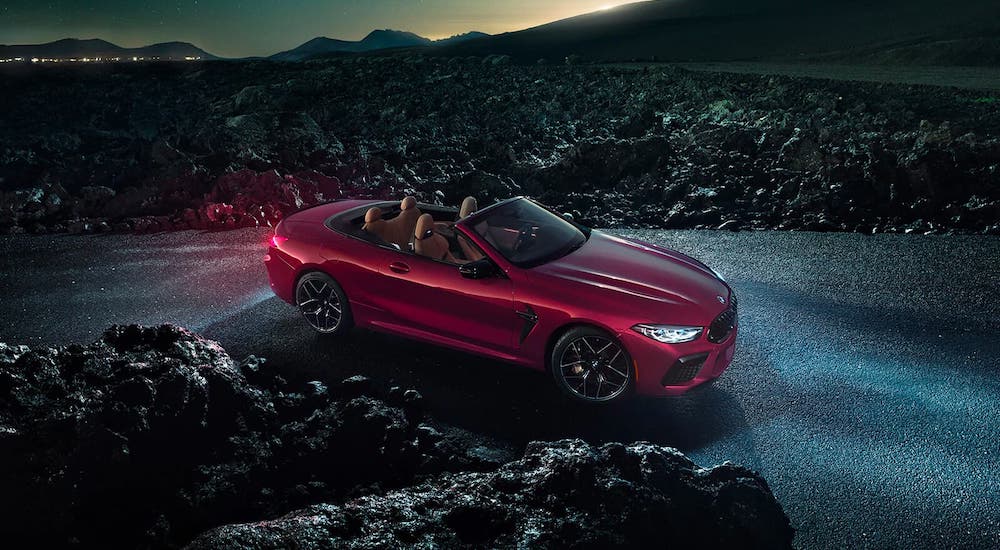M is the most powerful letter in the world – at least according to BMW. While every car and SUV wearing the blue and white pinwheel badge is built to be a joy to drive, it is the tri-color badge of the BMW M Series that marks the ultimate Bavarian performance cars. These chosen vehicles may resemble the more common BMW models, but inside they are entirely different machines designed from the ground up for maximum speed and handling.
Not only are the BMW M Series cars given more powerful engines, but they also receive an uprated suspension, stiffer bodies, and a collection of cutting edge performance technologies. However, despite their phenomenal performance, the M Series models remain just as luxurious and comfortable as any other vehicle that carries the BMW name. Indeed, if a passenger fails to notice the subtle M Series markings, then they might just think that they are riding in a run of the mill luxury sedan or SUV. And if you’re interested in learning more about this fantastic vehicle series, keep reading!
When is an M not an M?
BMW actually sells three different types of cars that use M in their names, and they do not all share the same level of performance. These are the M Sport, the M Competition, and finally the true M Series. Simply put, the M Sport is an option package, the M Competition is a trim level, and the M Series is an actual model. The higher up the hierarchy, the more performance features that are included.
The M Sport package is mostly cosmetic upgrades, primarily replacing exterior chrome with sportier black trim, but it also includes some useful features such as larger wheels and more heavily bolstered sports seats. The M Competition trims are more serious and stand out for their more powerful engines and higher-tech performance features. In the case of the BMW 2 Series coupes, for example, the standard BMW 240i has a 2.0L engine with 248 hp while the M Competition version, the BMW M240i, has a 3.0L engine with 335 hp as well as the option for active suspension. The M Competition trims also add some significant cosmetic changes for a more aggressive appearance to match their higher performance. However, even the M Competition cars are not true BMW M Series vehicles.
Continuing with the BMW 2 Series example, the M Series variant of BMW’s smallest car is simply named the BMW M2 and is not even technically part of the larger 2 Series. In the factory codes sometimes used by BMW enthusiasts, the current BMW 2 Series is known as either the F22 or F23, depending on whether it is a hardtop or convertible, while the BMW M2 goes by the entirely separate designation F87. And this is not just marketing either. Line up a BMW M2 next to a regular BMW 2 Series car, and it will be seen that the M car is over three inches wider than its smaller counterpart. And while the BMW M2 and the BMW M240i are both powered by a 3.0L engine, the BMW M2 produces 405 hp or over 20 percent more than the BMW M240i.
And the rest of the powertrain is just as different. While the BMW M240i comes with a traditional eight-speed automatic transmission and an open rear differential, the BMW M2 has a seven-speed dual-clutch transmission and an electronically controlled active differential. Further, the BMW M2 is fully track-ready with its uprated cooling system. And while this example only looks at BMW’s smallest coupe, the same pattern holds true for every BMW model. In short, the BMW M Series is the real deal when it comes to high-performance cars.
The M Series Family
Today, there are ten different models in the BMW M series. These include coupes, sedans, and SUVs, and range in size from the BMW M2 all the way up to the BMW X5 M. The only cars that do not get the M Series treatment are the BMW 3 Series and the BMW 7 Series. This is somewhat odd given that some of the well-regarded past members of the M Series, such as the iconic E30 and E46, were based on 3 Series cars. However, the lack of a modern BMW M3 is likely because the sportier two-door version of the 3 Series was dropped in favor of the relatively new BMW 4 Series. And with the choice between the M2, M4, M5, and three flavors of the M8, there are enough M Series cars to satisfy nearly anyone.
But the same cannot necessarily be said of BMW M Series SUVs. Of BMW’s seven SUV models, only four have M Series variants. And while the fact that there is not yet an M version of the new three-row BMW X7 is perfectly understandable on several levels, the absence of an M Series take on the lighter and sportier BMW X1 and BMW X2 is somewhat inexplicable. While the argument could be made that a front-wheel drive platform is unsuitable for an M vehicle, this is somewhat moot as all of the BMW SUVs are all-wheel drive models. Still, with the option of the X3 M, X4 M, X5 M, and X6 M, it cannot be said that BMW does not have a wide selection of performance SUVs.
Which M Car (or SUV) to Choose?
For drivers chasing raw speed and acceleration, the BMW M8 Competition is the fastest BMW available. With all-wheel drive and a twin-turbo 4.4L V8 engine producing 617 hp and 553 lb-ft of torque, this incredible vehicle can accelerate from 0 to 60 in just 3 seconds flat and will not stop until the speedometer hits 190 mph. Available as a two-door coupe, as a two-door convertible, or as a four-door “gran coupe” that can comfortably fit the whole family when not tearing around the racetrack, the BMW M8 also has the most variants of any single M car. And as BMW’s flagship model, the M8 is filled with premium features that make it a symbol of luxury as well as performance.
But lots of power and features do not always make for the most enjoyable vehicle. Drivers seeking the purest driving experience might find themselves happier in the BMW M2 Competition. Although its 4.2 second 0 to 60 time and 174 mph top speed may seem slow next to the BMW M8 Competition, with rear-wheel drive, a six-speed manual transmission, and a curb weight over a quarter ton lighter than the lightest M8 variant, the BMW M2 is one of the best driver’s cars available today. And while it may not have all the bells and whistles of its larger siblings, the M2 is still a true luxury sport sedan that will provide a pleasant ride when it is not pushing the limits.
For drivers interested in the SUV side of the M Series lineup, there is slightly less variety, and all four choices are solid options. However, probably the best all-around vehicle is the trusty BMW X3 M. While its 473 hp twin-turbo inline-six engine is not as powerful as the eight-cylinder power plants that the BMW X5 M and BMW X6 M share with the BMW M8 variants, the much lighter weight of the BMW X3 M means that its 4.1 second 0 to 60 time is not far behind that of the larger SUV models and makes it a much nimbler vehicle on twisty roads. Still, it is impossible to go wrong with any member of the BMW M Series, car, or SUV. Afterall, M is the most powerful letter in the world.






